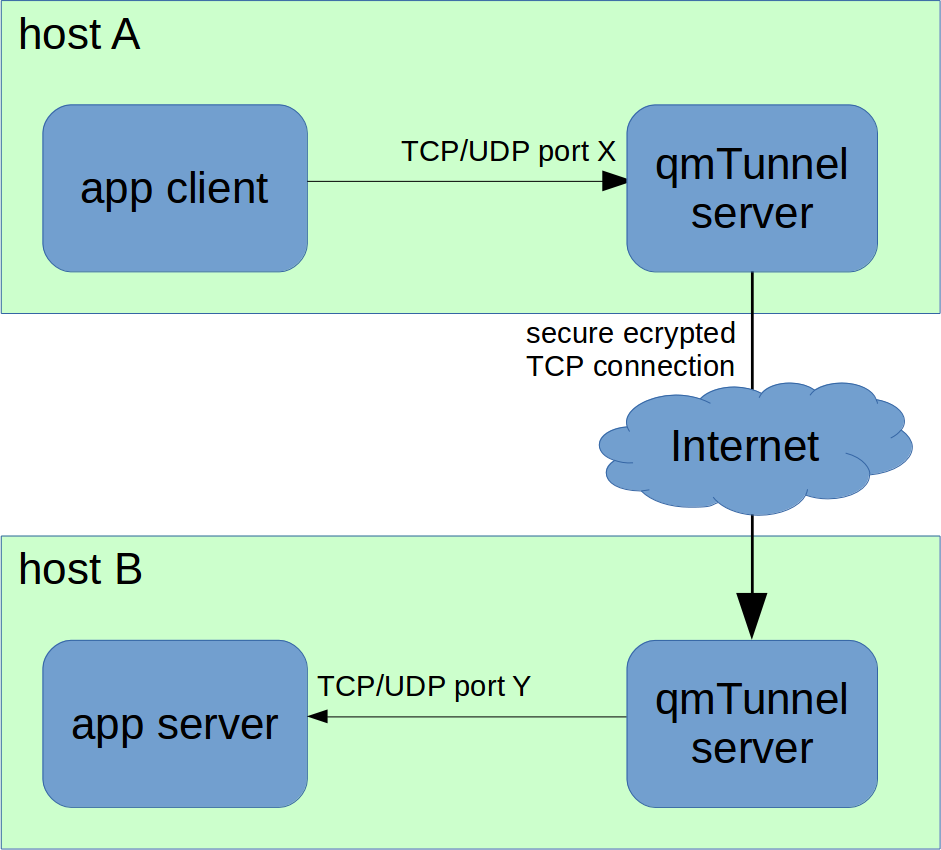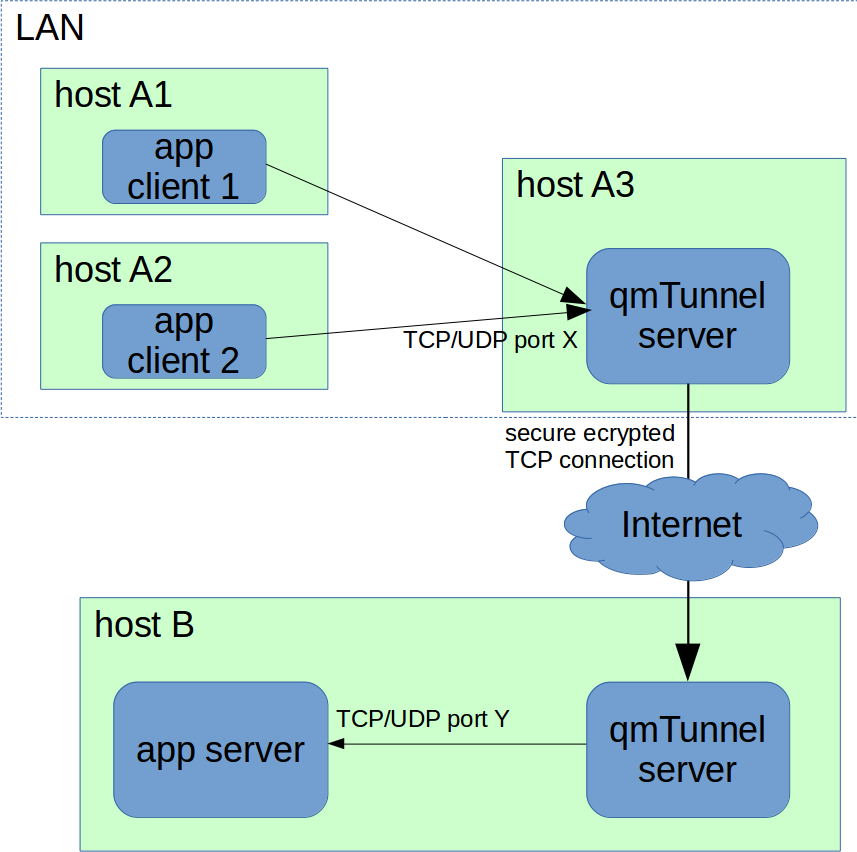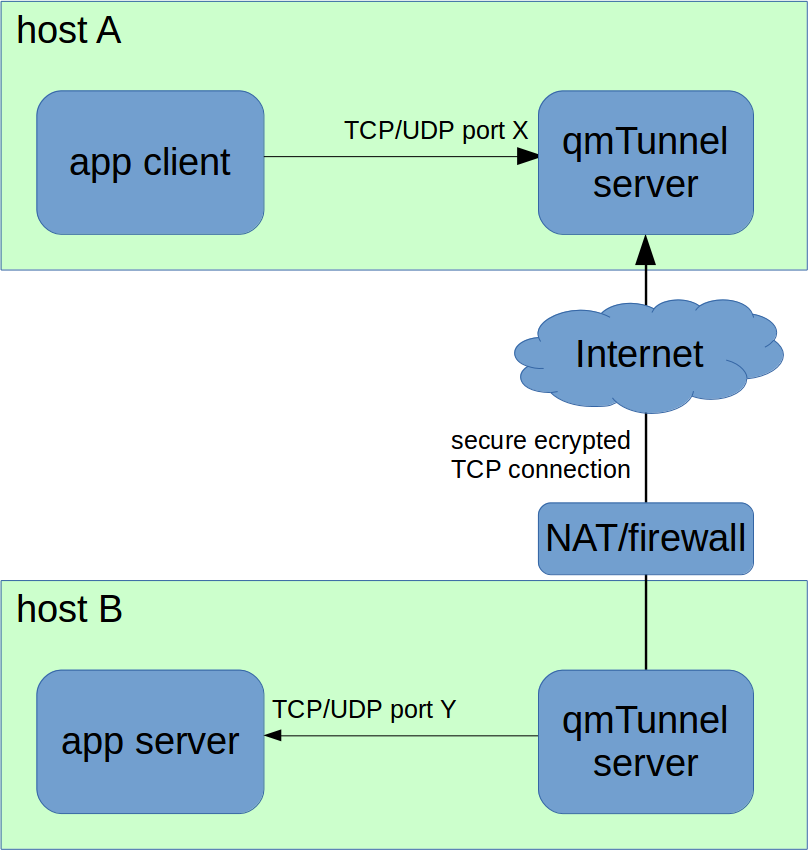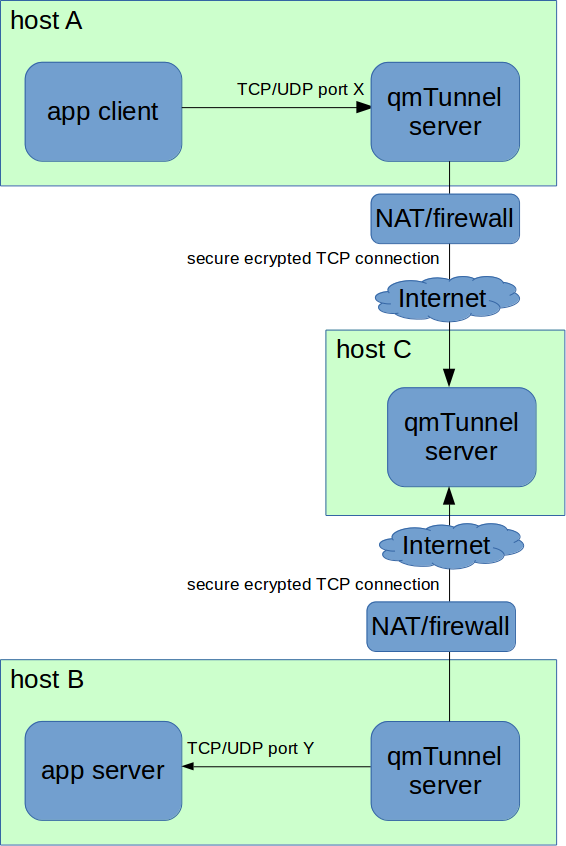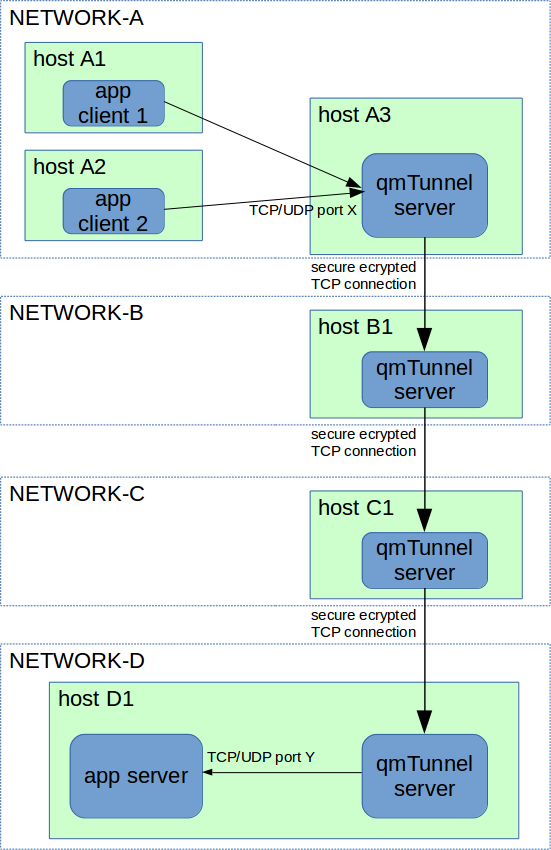Introduction¶
qmTunnel is a free cross-platform open source tunneling software allowing you to wrap up and tunnel all types of TCP, UDP or named pipe connections through a set of tunnel software servers.
You may find qmTunnel useful if you need (all features are optional):
- to secure your connection with SSL/TLS;
- to connect to hosts/networks behind NAT/firewall;
- to compress your traffic;
- to detect silent packet drops and disconnections (by enabling heartbeats);
- to allow short-time disconnections between tunnel hosts with no application disconnections;
- to add additional authentication level to tunnel hosts;
- to automatically re-establish the tunnel on disconnections (permanent tunnel);
- to establish tunnel only when needed (on demand).
Basically your application client connects to qmTunnel server instead of connecting directly to application server. Then qmTunnel server makes further connections to next qmTunner server and the last qmTunnel server in chain connects to your application server, transparently (for application client and server) transferring all application data from application client to the application server (and vice versa) and allowing to secure and tune the connections between qmTunnel servers.
How it works¶
The most simple case can be illustrated by the following figure:
When tunnel is configured on «host A», the connection is established in the following order:
- Application client connects to local (on the same node or network) qmTunnel server on specified TCP or UDP port «X» on «host A».
- qmTunnel server on «host A» connects to qmTunnel server on «host B» and establishes encrypted (SSL/TLS) connection.
- qmTunnel server on «host B» connects to local (same node or network) application server on specified TCP or UDP port «Y». «X» might be the same as «Y», or not.
- All the data transmitted by the application client will be delivered through the tunnel to the application server and vice versa.
Application might be any application or service using TCP, UDP or Unix sockets. For example:
- E-mail (SMTP, POP3, IMAP)
- Databases or data storages (MySQL, PostgreSQL, Oracle, SQL Server, etc.)
- Remote desktop and shell (VNC, RDP, SSH, etc.)
- DNS
- any other
In case you need to provide tunnel access to your LAN it’s possible to do so:
It’s also possible that host «B» is not available from the Internet and can’t accept incoming connections, e.g. located behind NAT/firewall or doesn’t have real IP address or domain name. In this case «remote» (or «reverse») tunnel can help:
«Remote» (or «reverse») tunnel means that it’s «host B» who initiates the connection to «host A», and also the tunnel needs to be initiated on «host B» instead of «host A».
The next possible scenario is that both application client and server are behind NAT/firewall and incoming connections can’t be accepted from outside. In this case you will need a third host acting as communication server/proxy:
In this case you need to create 2 separate tunnels:
- On «host A»: local forwarding tunnel from port «X» to «host C» port «Z».
- On «host B»: remote forwarding tunnel from «host C» port «Z» to local port «Y».
Your tunnel’s host chain length is not limited if you need to pass through a few gateways:
Architecture¶
qmTunnel consists of 2 modules:
- qmTunnel-server — server module which needs to be started on all tunnel hosts
(at least two).
It’s possible to run qmtunnel-server as GUI application or as background console
application (use
-daemoncommand line parameter). - qmTunnel-gui — GUI which connects to qmtunnel-server instances (including remote ones) and allows to configure them and create/edit/monitor tunnels.
qmTunnel is a free open source cross-platform application and runs on Linux, Windows and possibly (haven’t tested yet) MacOS.
To build and run qmTunnel, you only need Qt4/Qt5 and OpenSSL libraries.
License¶
qmtunnel is released under GNU General Public License 3.0, with the additional special exception to link portions of this program with the OpenSSL library. See LICENSE file for more details.
Support¶
qmtunnel is open-source project, which means it’s considered to be supported by the community.
However if you wish to use it in production environment, commercial support is also available from the author and maintainer of this project. Contact support@qmtunnel.com for details. This way you can also support the project.
Copyrights¶
Copyright (c) 2017 Nikolay N. Karikh (knn@qmtunnel.com)
LEGAL NOTICE: This product includes software developed by the OpenSSL Project for use in the OpenSSL Toolkit (http://www.openssl.org/)
Copyright (c) 1998-2017 The OpenSSL Project
Copyright (c) 1995-1998 Eric A. Young (eay@cryptsoft.com), Tim J. Hudson (tjh@cryptsoft.com)
All rights reserved.
